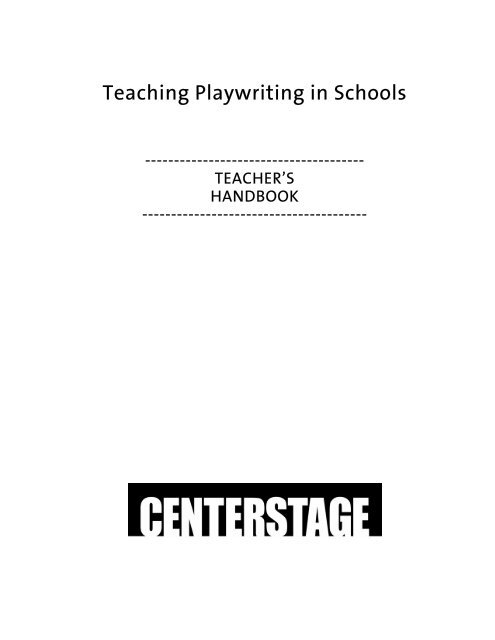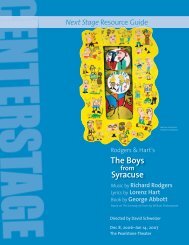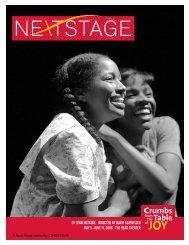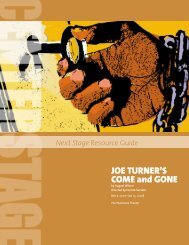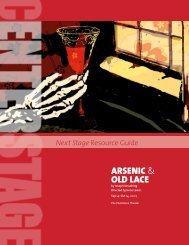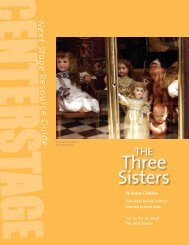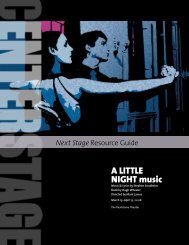Teaching Playwriting in Schools - Center Stage
Teaching Playwriting in Schools - Center Stage
Teaching Playwriting in Schools - Center Stage
You also want an ePaper? Increase the reach of your titles
YUMPU automatically turns print PDFs into web optimized ePapers that Google loves.
<strong>Teach<strong>in</strong>g</strong> <strong>Playwrit<strong>in</strong>g</strong> <strong>in</strong> <strong>Schools</strong><br />
--------------------------------------<br />
TEACHER’S<br />
HANDBOOK<br />
---------------------------------------
INTRODUCTION<br />
CONTENTS<br />
A NOTE TO TEACHERS............................................................................................... 2<br />
STRUCTURE SUGGESTIONS...................................................................................... 3<br />
SUGGESTED USES FOR PLAYWRITING ACROSS THE CURRICULUM............... 3<br />
PLAYWRITING VOCABULARY LIST...........................................................................<br />
REWRITING<br />
4<br />
A NOTE ABOUT REWRITING..................................................................................... 5<br />
GENERAL CHECKLIST FOR SUCCESSFUL REWRITING......................................... 5<br />
COMMON PROBLEMS IN STUDENT PLAYS............................................................ 6<br />
Dialogue.......................................................................................................... 6<br />
Characters...................................................................................................... 8<br />
Conflict............................................................................................................ 9<br />
Plots/Scenes................................................................................................... 11<br />
ADDITIONAL EXERCISES & WORKSHEETS<br />
EXERCISES FOR DEVELOPING OBSERVATION SKILLS.......................................... 13<br />
ACTION VS. ACTIVITY................................................................................................. 14<br />
ROUND ROBIN/SECRETS........................................................................................... 15<br />
STORY OF A JOURNEY................................................................................................ 16<br />
THE NEUTRAL PLAY.................................................................................................... 17<br />
BUILDING A CHARACTER.......................................................................................... 18<br />
CONFLICT SCHEME..................................................................................................... 19<br />
PLAYWRITING QUESTIONNAIRE............................................................................. 20<br />
OPENING LINES........................................................................................................... 21<br />
QUESTIONS FOR THE PLAYWRIGHT (REWRITING)............................................. 23<br />
OTHER PLAYWRITING FESTIVALS AND AWARDS ......................................................... 25<br />
1
A Note to Teachers<br />
Introduction<br />
This handbook has been designed to help you br<strong>in</strong>g playwrit<strong>in</strong>g <strong>in</strong>to your classroom. It is our<br />
hope that these exercises, worksheets, evaluations, and suggestions can help you <strong>in</strong> teach<strong>in</strong>g<br />
playwrit<strong>in</strong>g as a part of your curriculum.<br />
In addition to provid<strong>in</strong>g you with the <strong>in</strong>formation to teach playwrit<strong>in</strong>g, we also hope to give<br />
students the opportunity to see their work produced and staged here at CENTERSTAGE. Each spr<strong>in</strong>g<br />
we sponsor the Young Playwright’s Festival, which encourages students <strong>in</strong> grades 1 through 12 to<br />
submit their orig<strong>in</strong>al plays. Selected plays will be honored with staged read<strong>in</strong>gs that will be produced<br />
by CENTERSTAGE, while some others receive playwrit<strong>in</strong>g workshops with a professional playwright.<br />
This year marks the 20 th anniversary of the Young Playwrights Festival, and <strong>in</strong> hopes of mak<strong>in</strong>g this<br />
year bigger and better we want to encourage as many students as possible to submit their work.<br />
Please use the <strong>in</strong>formation with<strong>in</strong> these pages freely. Alter them to fit your <strong>in</strong>dividual needs.<br />
Much of the handbook is designed to help with the completion and revision of plays written by<br />
students. Students should be encouraged to be creative and experimental, to discover their own voice<br />
and express it <strong>in</strong> new and challeng<strong>in</strong>g ways. To emphasize that theater is to be experienced, not<br />
simply read, students can act out their own scenes from their develop<strong>in</strong>g scripts. The follow<strong>in</strong>g words<br />
of wisdom will help nurture your students’ creative process.<br />
Good playwrit<strong>in</strong>g may come from very humble beg<strong>in</strong>n<strong>in</strong>gs.<br />
• Student scenes, even <strong>in</strong> their first draft, are an achievement.<br />
• The best th<strong>in</strong>g you can do for student writers is give them the opportunity to write without<br />
censure; to write “anyth<strong>in</strong>g” she or he would like a character to say or do. Eventually, some<br />
guidel<strong>in</strong>es will be drawn, but <strong>in</strong> the beg<strong>in</strong>n<strong>in</strong>g try to <strong>in</strong>fluence or edit as little as possible.<br />
• Revision is important and necessary. It takes time, make sure to plan ahead.<br />
Playwrights benefit greatly from hear<strong>in</strong>g their work read aloud.<br />
• This is a very important step <strong>in</strong> understand<strong>in</strong>g how the play and its several elements work.<br />
• Theater is a “live” experience. We encourage you to set some time aside for br<strong>in</strong>g<strong>in</strong>g their<br />
plays to life, whether it is just a read<strong>in</strong>g or if it is fully staged.<br />
Rem<strong>in</strong>d the students that, <strong>in</strong> the end, it’s their play.<br />
• Stress the importance of giv<strong>in</strong>g, receiv<strong>in</strong>g, and process<strong>in</strong>g constructive criticism.<br />
• Theater is a collaboration.<br />
• If they do not want to make suggested changes, it is their choice.<br />
2
Structure Suggestions<br />
Here is one way to structure a playwrit<strong>in</strong>g unit <strong>in</strong> five days, which can be consecutive or<br />
divided <strong>in</strong> whatever way best fits your schedul<strong>in</strong>g needs.<br />
In the first lesson, the teacher addresses playwrit<strong>in</strong>g vocabulary, particularly character,<br />
dialogue, and conflict. Break down the structure of scenes and plays to <strong>in</strong>troduce the concept of goals<br />
and obstacles, the nature of conflict, the revelation of character, and the progression of an action. She<br />
or he uses a variety of methods—trigger photos, improvisation, and worksheets—to stimulate the<br />
student’s imag<strong>in</strong>ation to identify their <strong>in</strong>dividual creative ideas, stories, and characters. Students<br />
should start to write immediately.<br />
After the <strong>in</strong>troductory class, the next three classes beg<strong>in</strong> with a brief review of the previous<br />
day’s work, a discussion about its presentation, and analysis of student writ<strong>in</strong>g. To <strong>in</strong>troduce revision,<br />
the teacher uses student written scenes and monologues for analysis. Student scenes are read aloud<br />
and staged throughout the week. Both the class and teacher suggest revisions.<br />
The last day is focused on the performance of student scenes. The teacher can describe<br />
CENTERSTAGE’s Young Playwrights Festival to prepare scripts for possible submission.<br />
Uses for playwrit<strong>in</strong>g across the curriculum<br />
• Pre-writ<strong>in</strong>g: conflict scheme, questions about your story or scene, build<strong>in</strong>g a character.<br />
• Four goals of playwrit<strong>in</strong>g practice: sett<strong>in</strong>g, stage directions, scene with dialogue (to show a<br />
situation), character conflict<br />
• Revision: discussion questions about scenes.<br />
• Dramatize and act out a historical event. (George Wash<strong>in</strong>gton at Valley Forge, Harriet Tubman<br />
and the Underground Railroad, Mart<strong>in</strong> Luther K<strong>in</strong>g fac<strong>in</strong>g conflict between the Civil Rights<br />
struggle, etc.)<br />
• Act out orig<strong>in</strong>al student plays.<br />
• Create and act out dramatic monologues through personification. (Monologues about forces<br />
of weather, the animal world, the plant world, etc.)<br />
• Create conflicts and dramatic scenes out of personal and family material, family legends,<br />
contact with the elderly, and visitors to the classroom.<br />
• Create conflicts and dramatic scenes from personal life issues and life style themes, and social<br />
issues. (Relationships, ethics, personal safety, drug and sex issues, community issues, etc.)<br />
• Create conflicts and dramatic scenes from pictures cut out of newspapers and magaz<strong>in</strong>es<br />
us<strong>in</strong>g the imag<strong>in</strong>ation to expand on what’s <strong>in</strong> the picture to create characters, goals, and<br />
obstacles.<br />
3
<strong>Playwrit<strong>in</strong>g</strong> Vocabulary List<br />
CHARACTER: who the actor pretends to be. (Characters want th<strong>in</strong>gs. They have goals and objectives.)<br />
DIALOGUE: a conversation between two or more characters.<br />
CONFLICT: obstacles that get <strong>in</strong> the way of a character achiev<strong>in</strong>g what he or she wants. What the<br />
characters struggle aga<strong>in</strong>st.<br />
SCENE: a s<strong>in</strong>gle situation or unit of dialogue <strong>in</strong> a play.<br />
STAGE DIRECTIONS: messages from the playwright to the actors, technicians, and others <strong>in</strong> the<br />
theater tell<strong>in</strong>g them what to do and how to do it.<br />
SETTING: time and place of a scene.<br />
BIOGRAPHY: a character’s life story that a playwright creates.<br />
MONOLOGUE: a long speech one character gives on stage.<br />
DRAMATIC ACTION: an explanation of what the characters are try<strong>in</strong>g to do.<br />
BEAT: a smaller section of a scene, divided where a shift <strong>in</strong> emotion or topic occurs.<br />
PLOT: the structure of a play, <strong>in</strong>clud<strong>in</strong>g exposition, ris<strong>in</strong>g action, climax, fall<strong>in</strong>g action, and<br />
denouement.<br />
EXPOSITION: the beg<strong>in</strong>n<strong>in</strong>g part of a plot that provides important background <strong>in</strong>formation.<br />
RISING ACTION: the middle part of a plot, consist<strong>in</strong>g of complications and discoveries that create<br />
conflict.<br />
CLIMAX: the turn<strong>in</strong>g po<strong>in</strong>t <strong>in</strong> a plot.<br />
FALLING ACTION: the series of events follow<strong>in</strong>g the climax of a plot.<br />
DENOUEMENT: the f<strong>in</strong>al resolution of the conflict <strong>in</strong> a plot.<br />
4
Rewrit<strong>in</strong>g<br />
Rewrit<strong>in</strong>g is one of the most difficult and essential parts of playwrit<strong>in</strong>g. It is so hard for a<br />
writer to revise, regardless of age or experience. However, once a student experiences the benefits of<br />
an <strong>in</strong>teractive revision process, they understand that revision is about possibilities, not mistakes.<br />
For many younger students, the act of rewrit<strong>in</strong>g is a new experience. The idea of the first draft<br />
as exactly that—a “draft” to cover with l<strong>in</strong>es, arrows, cross-outs, and new ideas—can be liberat<strong>in</strong>g.<br />
But <strong>in</strong> ask<strong>in</strong>g the young writer to rewrite, you will often have to help him/her understand that scenes<br />
will be strengthened by multiple visits and extra work.<br />
This section <strong>in</strong>cludes suggestions for approach<strong>in</strong>g revision <strong>in</strong> the classroom. The typical<br />
problems of student playwrights are identified. Exercises designed to let the student work out the<br />
“problems” themselves through further bra<strong>in</strong>storm<strong>in</strong>g are <strong>in</strong>cluded.<br />
General Checklist for Successful Rewrit<strong>in</strong>g<br />
• Have I written all the scenes the audience needs to see and hear? Do I need any scenes before<br />
or after to develop character and conflict?<br />
• Is the play focused on the ma<strong>in</strong> character and conflict? How can I focus it?<br />
• Are conflict and character developed through the dialogue?<br />
• Have I expressed as much as possible through the dialogue, avoid<strong>in</strong>g narration?<br />
• Have I provided sett<strong>in</strong>gs? Do the sett<strong>in</strong>gs contribute to the action?<br />
• Is my work divided <strong>in</strong>to scenes where appropriate?<br />
• Does the audience get to know the characters well enough to care about them?<br />
• Are my characters different from each other? Do they speak <strong>in</strong> characteristic ways? (Speech<br />
patterns, style, attitudes, tone, etc.)<br />
• Are there any characters I should elim<strong>in</strong>ate because they aren’t really necessary?<br />
• Are my characters well developed? Do I know them as well as I should? Have I revealed as<br />
much as I need to about them? How can I develop them further? Scenes? Monologues?<br />
• Do I know what my characters want? Will the audience know? Are their goals clear?<br />
• Have I thrown <strong>in</strong>terest<strong>in</strong>g and challeng<strong>in</strong>g obstacles <strong>in</strong>to my characters’ paths? Are they<br />
struggl<strong>in</strong>g? Do people become obstacles for each other?<br />
• Is the central conflict or struggle of my play an <strong>in</strong>terest<strong>in</strong>g one?<br />
• Do the characters change? How can I put the characters through a believable change?<br />
• Have I avoided resolv<strong>in</strong>g the conflict too soon?<br />
• Is the audience always curious to know what happens next?<br />
• What does happen next? Could I write that scene, too?<br />
5
Problems:<br />
Common Problems <strong>in</strong> Student Plays<br />
Dialogue<br />
1. Narration—Often the student playwright will make use of a narrator that speaks to the<br />
audience as characters do. This should be avoided. The story is best told through the revelation of<br />
<strong>in</strong>formation by dialogue and action: what the characters say and do. Show, don’t tell.<br />
2. Too little/Too much <strong>in</strong>formation—The whole story is not shared with the audience or there<br />
are details not important to the story presented (this can be hard to judge).<br />
3. Recycled l<strong>in</strong>es—dialogue consists of recycled l<strong>in</strong>es from movies, etc.<br />
4. Too little dialogue—Try hav<strong>in</strong>g students create a scene with no action; where we must learn<br />
about a character only through what he or the other characters say.<br />
Questions for the Playwright to ask:<br />
• How might the characters’ true feel<strong>in</strong>gs be communicated to the audience through dialogue?<br />
• What dialogue could be cut without damag<strong>in</strong>g the story?<br />
• What narrative clues have been left out?<br />
• What is your favorite piece of dialogue? Why?<br />
• Can you th<strong>in</strong>k of a way to say this that is truer to the character?<br />
• How does each character feel about the other characters?<br />
• Do we know this by someth<strong>in</strong>g he or she says?<br />
• Can you imag<strong>in</strong>e someth<strong>in</strong>g he or she might say or do, feel<strong>in</strong>g the way she or he does?<br />
6
Exercises for sharpen<strong>in</strong>g dialogue skills:<br />
“The Other End”<br />
Ask the students if they have ever heard someone talk<strong>in</strong>g on the telephone and tried to<br />
imag<strong>in</strong>e what the other half of the conversation was like? Have them observe a phone conversation<br />
tak<strong>in</strong>g place and then try writ<strong>in</strong>g down both sides of the conversation—the side they over-hear and<br />
the side they imag<strong>in</strong>e.<br />
“TV Writer”<br />
Have the students turn on a television program, especially one unfamiliar to them, and watch<br />
for 5–10 m<strong>in</strong>utes with the sound muted. While they are watch<strong>in</strong>g, they should write down what they<br />
th<strong>in</strong>k the characters are say<strong>in</strong>g to each other. Encourage them to practice first without writ<strong>in</strong>g. While<br />
they are mak<strong>in</strong>g up the dialogue, questions they should th<strong>in</strong>k about are:<br />
• Who are these people?<br />
• What do they want from each other (if anyth<strong>in</strong>g)?<br />
• What are their relationships to one another?<br />
• Do they have a conflict?<br />
• What <strong>in</strong>terest<strong>in</strong>g th<strong>in</strong>gs will happen to them?<br />
• How will it all end?<br />
7
Common Problems <strong>in</strong> Student Plays<br />
Characters<br />
Problems:<br />
1. Characters are not unique—They do not have an <strong>in</strong>dividual way of speak<strong>in</strong>g. This is one of<br />
the most common problems for new playwrights—every character sounds the same, uses the<br />
same slang, dialect, etc..., normally the characters’ voices are identical to the playwright’s<br />
manner of speak<strong>in</strong>g.<br />
2. Believability—The characters do or say unbelievable th<strong>in</strong>gs, behav<strong>in</strong>g contrary to their nature<br />
without causation. (i.e. A grumpy man suddenly buy<strong>in</strong>g presents for the neighborhood<br />
children is unbelievable; when he has been visited by three ghosts, shown the error of his<br />
ways, and then buys the presents, the activity becomes believable.)<br />
3. Too many characters—There are characters present who are unnecessary to the story be<strong>in</strong>g<br />
told. A surplus of characters can confuse or muddle the story and burden the playwright as<br />
well.<br />
4. Characters not fully developed—Characters are <strong>in</strong>complete or not “whole,” which prevents<br />
people from connect<strong>in</strong>g with them and car<strong>in</strong>g what happens to them.<br />
Questions for the Playwright to ask:<br />
• Who is this character?<br />
• What else might this character do?<br />
• What might this character say?<br />
• Why does the character do/say what he does?<br />
• Does your character have a secret?<br />
• What k<strong>in</strong>d of mood is he <strong>in</strong> now?<br />
• Are all of these characters necessary?<br />
• Where is the focus of the scene?<br />
• How does the character’s background affect what he says?<br />
• What is his relation to the other characters?<br />
• Do you care about this character? Why?<br />
• Who is the story about?<br />
8
Common Problems <strong>in</strong> Student Plays<br />
Conflicts<br />
Problems:<br />
1. No Conflict—There are no obstacles to characters’ wants. The obstacles she or he is presented<br />
with are easily overcome. The problems are m<strong>in</strong>or and the result<strong>in</strong>g conflict lacks<br />
consequence.<br />
2. Conflict resolved too quickly—The change the characters present is not believable because it<br />
occurs too soon or too easily. The conflict does not sufficiently challenge the characters.<br />
3. Unfocused conflict—It is unclear what the conflict is about and/or why the characters are<br />
<strong>in</strong>volved <strong>in</strong> it. Perhaps there are too many characters or not enough dialogue.<br />
4. Conflict does not progress—The central conflict or dramatic action does not effect change <strong>in</strong><br />
the scene. Change happens <strong>in</strong>dependent of the ma<strong>in</strong> conflict of the play.<br />
Questions for the Playwright to ask:<br />
• Does the character have to sacrifice anyth<strong>in</strong>g to achieve his or her goal? How big a sacrifice?<br />
• Can you clarify the goal of each character and the obstacles to achiev<strong>in</strong>g his or her goals?<br />
• How did the character change and what <strong>in</strong>itiated the change?<br />
• What needs to happen between these two characters to make their change believable?<br />
• Who is this play about?<br />
• What does this character want?<br />
• What is stopp<strong>in</strong>g this character from gett<strong>in</strong>g what he or she wants? (Insist<strong>in</strong>g on one-sentence<br />
answers assists <strong>in</strong> focus<strong>in</strong>g.)<br />
• What is the conflict <strong>in</strong> this scene?<br />
• Why is there a conflict?<br />
9
Exercises for sharpen<strong>in</strong>g conflict skills:<br />
“Problem-solv<strong>in</strong>g”<br />
Use the blackboard or a tape recorder to record ideas to develop <strong>in</strong>to a play. Prepare questions that<br />
will provoke discussion and complicate the scenario. Creat<strong>in</strong>g “out loud” is often more <strong>in</strong>volv<strong>in</strong>g for the<br />
imag<strong>in</strong>ation. (NOTE: Questions can make each scenario come alive. “And then what happened?” is the<br />
most-asked question <strong>in</strong> any story!) Some ideas:<br />
• Darnell, who is ten years old, is constantly be<strong>in</strong>g harassed by Reed, an eleven-year-old bully. Reed<br />
has even been extort<strong>in</strong>g money from Darnell. What can Darnell do to stop Reed from harass<strong>in</strong>g<br />
him?<br />
• Elizabeth’s parents are go<strong>in</strong>g away for a three-day weekend. Although Elizabeth has a license, her<br />
parents do not want her to drive while they are away. What does Elizabeth do when her boyfriend<br />
comes over and wants to go out with her?<br />
• Ellis is the fourth-grade clown. He will do anyth<strong>in</strong>g for a laugh. Some of his classmates love him for<br />
it, others hate him for it. Underneath, Ellis is very lonely and has no real friends. One day, a new boy,<br />
James, comes to town. Immediately, no one (<strong>in</strong>clud<strong>in</strong>g Ellis) likes him. One day Ellis and James<br />
meet by chance <strong>in</strong> the park. No one else is around. What happens?<br />
• Eddie, an eighth-grader <strong>in</strong> middle school, is suddenly stricken with love for Sonya, a n<strong>in</strong>th-grader <strong>in</strong><br />
high school who hardly notices him at all. Eddie desperately wants to go out with Sonya, but is<br />
nervous and afraid that he will be rejected. What does he do? Who, if anyone, does he elicit help<br />
from?<br />
• Bob and Barbara who are good friends, go out shopp<strong>in</strong>g for a birthday present for another friend;<br />
but they both want to buy the same gift. What happens?<br />
• Jill and Joe, who are friends, are both suspended from school for the same reason. What happens<br />
when they go home and tell their respective parents? Do they both tell the same story?<br />
• Tammy likes Tom, a boy <strong>in</strong> her class. She wants to ask him to have d<strong>in</strong>ner at her house, but she is<br />
afraid he will say “no”. What happens?<br />
• Steve wants Susan to go to a rock concert with him, but Susan’s father doesn’t th<strong>in</strong>k she should go.<br />
Why? What happens?<br />
• Lee builds a rocket <strong>in</strong> the family garage. What happens when it is stolen? Who stole it?<br />
• Chris f<strong>in</strong>ds a magic lantern and is granted three wishes. What happens when the first wish br<strong>in</strong>gs<br />
misfortune?<br />
10
Problems:<br />
Common Problems <strong>in</strong> Student Plays<br />
Plots/Scenes<br />
1. More scenes needed—More scenes are needed to understand how the conflict/plot<br />
developed to this po<strong>in</strong>t, what happens <strong>in</strong> the scene, or what happens next.<br />
2. Unnecessary <strong>in</strong>formation—Information provided <strong>in</strong> the scene does not help us learn<br />
about the characters <strong>in</strong> a mean<strong>in</strong>gful way. Excessive details muddle the story and detract<br />
from the plot l<strong>in</strong>e.<br />
3. Sett<strong>in</strong>gs change too fast—There are two many m<strong>in</strong>i-scenes which might be more<br />
effective if comb<strong>in</strong>ed <strong>in</strong>to a few larger scenes <strong>in</strong> one or two locations.<br />
4. Sett<strong>in</strong>g is not specific enough—More details are needed to let the audience know the<br />
location—character reference, set dress<strong>in</strong>g, etc.<br />
5. Special effects—The scenes are more feasible for film or television (i.e. they conta<strong>in</strong> car<br />
chases, jump<strong>in</strong>g from one elaborate location to another, large explosions).<br />
Questions for the Playwright to ask:<br />
• What happened before this?<br />
• What happens next?<br />
• When does the scene take place?<br />
• What can be done <strong>in</strong> this scene to further the story/plot?<br />
• Why does this action have to happen here?<br />
• What story does the scene tell?<br />
• What <strong>in</strong>formation do we get from this scene?<br />
• How do the characters feel <strong>in</strong> this scene? How might they show it through their actions?<br />
• What is this character do<strong>in</strong>g when…?<br />
• What else could this character have been do<strong>in</strong>g?<br />
• What other th<strong>in</strong>gs could happen <strong>in</strong> this scene?<br />
11
Exercises for sharpen<strong>in</strong>g plots/scenes skills:<br />
“Creat<strong>in</strong>g Characters from Photographs”<br />
Break the class <strong>in</strong>to groups and have them appo<strong>in</strong>t a secretary <strong>in</strong> each group to record the<br />
<strong>in</strong>formation generated. Pass out one photograph or magaz<strong>in</strong>e picture, conta<strong>in</strong><strong>in</strong>g two to four people<br />
<strong>in</strong> it, to each group. Instruct the students to exam<strong>in</strong>e the photographs, look<strong>in</strong>g for “clues” as to what<br />
type of characters these people are and what type of situation they are <strong>in</strong>.<br />
1. Give each character a:<br />
a. Name<br />
b. Age<br />
c. Occupation<br />
d. Short family biography<br />
e. Dist<strong>in</strong>guish<strong>in</strong>g characteristics (physical or personality)<br />
2. Briefly describe the relationship between the characters.<br />
3. In one or two sentences describe what is happen<strong>in</strong>g <strong>in</strong> the photo/picture.<br />
4. Note how each character perceives the situation and what they want out of it—at least<br />
one paragraph for each character. (Rem<strong>in</strong>d the students that each character will have his<br />
or her or her own po<strong>in</strong>t of view about what is happen<strong>in</strong>g and will th<strong>in</strong>k that she or he<br />
knows best. Make each conflict specific to the character.)<br />
Break the groups up, mak<strong>in</strong>g sure each member has a copy of the character <strong>in</strong>formation.<br />
1. The students should write a story <strong>in</strong> narrative form, three paragraphs <strong>in</strong> length and<br />
<strong>in</strong>clud<strong>in</strong>g all the characters <strong>in</strong> some way.<br />
2. Transform the story <strong>in</strong>to three scenes with dialogue.<br />
It is important for the students to stick to the three paragraphs and three-scene format. It<br />
encourages them to have a def<strong>in</strong>ite beg<strong>in</strong>n<strong>in</strong>g, middle, and end.<br />
Variations<br />
• In the first scene have the characters reveal what they are th<strong>in</strong>k<strong>in</strong>g, but have one of them lie.<br />
Not only must the conflict be solved, but also the lie must be revealed <strong>in</strong> three scenes.<br />
• In the first scene all the characters are present simultaneously, and we learn the problem. The<br />
second scene has one of the characters deliver<strong>in</strong>g a monologue <strong>in</strong> which she or he relays to the<br />
audience a plan to address the problem. The last scene will be the implementation of that<br />
plan, and its success or failure.<br />
12
Additional Exercises & Worksheets<br />
Exercises for Develop<strong>in</strong>g Observation Skills<br />
Observation is a skill that all writers must cultivate to see and hear important details of<br />
people, places, and events. Ask the students:<br />
• Do you notice how people speak?<br />
• What is it about the way they speak or act that tells you when their mood changes?<br />
• Do you know people who say the same th<strong>in</strong>gs <strong>in</strong> different ways?<br />
People can want the same th<strong>in</strong>g, but they will go about atta<strong>in</strong><strong>in</strong>g their goals <strong>in</strong> different ways.<br />
For example, two men both want to make a great deal of money. One achieves his goal by becom<strong>in</strong>g<br />
the president of a bank. The other makes his money by robb<strong>in</strong>g the bank.<br />
Exercise One:<br />
Ask the students to write an observation of someone from their daily lives, someone who is<br />
not related to them and whom they do not know well—perhaps a neighbor or someone who comes<br />
<strong>in</strong>to their home on bus<strong>in</strong>ess.<br />
1. Describe this person physically (to the greatest detail possible).<br />
2. Tell us what you know about him or her from your observation.<br />
3. What would a scene <strong>in</strong>volv<strong>in</strong>g this person be like?<br />
Exercise Two:<br />
Overnight, assign the students to go <strong>in</strong>to their bedrooms and sit anywhere with a paper and<br />
pencil. Tell them to look about the room very slowly, from one end to the other, floor to ceil<strong>in</strong>g, and<br />
then pick one object and describe it <strong>in</strong> detail.<br />
Example: a photo<br />
Is the photograph on a table? Describe the table and the frame. Is the photo <strong>in</strong> color? Who is <strong>in</strong><br />
the photo? What do they look like? What are they wear<strong>in</strong>g? When was the photograph taken? Why do<br />
you have this person’s picture? How do you feel about this person? When was the photo given to you?<br />
Can you th<strong>in</strong>k of a conversation with this person? If so, write it. Can you describe or write a scene<br />
when you received it or when it became valuable to you? Write a scene about how you might feel if it<br />
were somehow lost or taken from you.<br />
The follow<strong>in</strong>g day, share the observations. After a student reads an observation aloud, the<br />
class might want to make suggestions about where they see a possible story develop<strong>in</strong>g; or, if a story<br />
has already begun to evolve, where it might lead. The student might be encouraged to expand on this<br />
story, which will re<strong>in</strong>force the realization that most writers f<strong>in</strong>d stories <strong>in</strong> what is happen<strong>in</strong>g around<br />
them—<strong>in</strong> what they see and hear.<br />
13
Action vs. Activity<br />
To beg<strong>in</strong> this exercise, ask the class the difference between ACTION and ACTIVITY, two<br />
playwrit<strong>in</strong>g terms that are often confused because they sound the same. ACTION refers to what a<br />
character wants and what is done to pursue this goal (i.e. character wants to go to a dance, but she<br />
doesn’t know how to dance. ACTION: she asks her sister to teach her how to dance.) ACTIVITY is<br />
physical stage bus<strong>in</strong>ess (i.e. fly<strong>in</strong>g a kite, iron<strong>in</strong>g a shirt, etc.). ACTION is <strong>in</strong>ner motivation and<br />
objective of a character.<br />
Divide the class <strong>in</strong> half. Ask each of half the kids to jot down an ACTIVITY. Ask each of the other<br />
half to create ACTIONS by decid<strong>in</strong>g who the characters are and what each wants.<br />
Toss the ACTIVITY suggestions <strong>in</strong>to one hat and the ACTION suggestions <strong>in</strong>to another. Pick one<br />
from each and have two students improvise a situation, an example of which might be:<br />
A younger sister wants her older sister to “teach her how to dance.” This improv<br />
beg<strong>in</strong>s while the sisters are <strong>in</strong>volved <strong>in</strong> the activity of “Climb<strong>in</strong>g Mt. Everest.”<br />
After the improv, discuss how and why the ACTIVITY enhances the ACTION, the characters, the<br />
conflict, etc. Do a few more improvs and cont<strong>in</strong>ue the discussion.<br />
ACTIVITY REVEALS ACTION: OUTER SIGN OF INNER REALITY.<br />
14
Round Rob<strong>in</strong><br />
Beg<strong>in</strong> to tell a story and cont<strong>in</strong>ue around the room with each person add<strong>in</strong>g to the plot,<br />
characters, etc. Use every idea, go forward and build on what’s been said. Write on the board the key<br />
po<strong>in</strong>ts—environment, names, etc. Once everyone has been given a chance to contribute, have<br />
everyone get out a piece of paper. They should each cont<strong>in</strong>ue the story, build to a climax, and resolve<br />
the conflict. Allow only 10-15 m<strong>in</strong>utes for this writ<strong>in</strong>g exercise. Have everyone share his or her ideas.<br />
This exercise helps students to th<strong>in</strong>k <strong>in</strong> terms of creat<strong>in</strong>g a beg<strong>in</strong>n<strong>in</strong>g, middle, and end as well<br />
as develop<strong>in</strong>g skills for listen<strong>in</strong>g and build<strong>in</strong>g upon previous events. Individual imag<strong>in</strong>ations will<br />
create surpris<strong>in</strong>g results from the <strong>in</strong>itial shared data.<br />
Secrets<br />
A good start for this exercise is to take the students through a brief relaxation exercise. When<br />
they are quiet and focused, ask them to close their eyes and th<strong>in</strong>k about someth<strong>in</strong>g about themselves<br />
that no one knows and that they wouldn’t want anyone else to know. (Make it clear at the beg<strong>in</strong>n<strong>in</strong>g<br />
that this is for them. They will not be asked to reveal this secret to anyone.) Have them write down<br />
their secret. Then ask them to imag<strong>in</strong>e if someone found out this secret. What would the scene look<br />
like? What would happen? How would you feel? Walk around with a trashcan and give them the<br />
chance to save or destroy their slips of paper.<br />
At least one student will ask what this exercise means. Expla<strong>in</strong> that many plays have<br />
characters with secrets, and that some of the greatest plays are centered on a character with a secret.<br />
To illustrate the dramatic impact, try one or more of the follow<strong>in</strong>g suggested improvisations:<br />
a.) Character X has a secret that affects Character Y, but doesn’t tell Y this; b.) Character X discovers a<br />
secret that Character Y has been keep<strong>in</strong>g, but doesn’t confront Y; c.) Character X confronts Character Y<br />
about the secret <strong>in</strong> either a or b.<br />
These exercises encourage students to create characters whose secrets make them complex<br />
and multi-dimensional. Part of the enjoyment of watch<strong>in</strong>g plays is discover<strong>in</strong>g the particular truth<br />
explored <strong>in</strong> the world of each play.<br />
15
Story of a Journey<br />
This is an exercise that comb<strong>in</strong>es improvisations with l<strong>in</strong>ear dramatic structure. Divide the<br />
class <strong>in</strong>to five groups. Each of these groups will now work to create its own part of the story.<br />
Group 1 will come up with 4-5 characters. They have to be related to each other <strong>in</strong> some<br />
manner (family members, co-workers, friends, etc.), but they can be any age, size, shape, ethnicity, etc.<br />
Encourage Group 1 to be as clear and detailed about their characters <strong>in</strong> any sett<strong>in</strong>g they choose.<br />
Groups 2, 3, and 4, <strong>in</strong> the meantime, create other sett<strong>in</strong>gs. All groups need to work<br />
<strong>in</strong>dependently, so no one knows (except Group 1) who the characters are or where the other groups<br />
are go<strong>in</strong>g to place them. There can be additional characters <strong>in</strong> each group’s sett<strong>in</strong>g (hunters <strong>in</strong> a<br />
jungle, server <strong>in</strong> a d<strong>in</strong>er, etc.).<br />
F<strong>in</strong>ally, Group 5 must develop a reason why any group of characters might want to arrive at a<br />
dest<strong>in</strong>ation of their choos<strong>in</strong>g. If their sett<strong>in</strong>g is Grandma’s house, the reason for go<strong>in</strong>g there is to<br />
celebrate her birthday at a surprise party.<br />
You now have the foundation of the story of a journey that can be scripted <strong>in</strong>to play form. The<br />
characters created by Group 1 have a dest<strong>in</strong>ation and a reason for gett<strong>in</strong>g there, created by Group 5.<br />
In order to accomplish the goal of arriv<strong>in</strong>g there, they must travel through the sett<strong>in</strong>gs created by<br />
Groups 2, 3, and 4—sett<strong>in</strong>gs that may well have other characters with whom they must <strong>in</strong>teract. The<br />
entire class can then outl<strong>in</strong>e the play and beg<strong>in</strong> to plan the dialogue. Then, each scene will be<br />
improvised with the students play<strong>in</strong>g the various parts.<br />
The play that results can be very strange and wildly funny. The students will also ga<strong>in</strong> a better<br />
understand<strong>in</strong>g of character development, story progress, and the relationship between characters’<br />
objectives, obstacles, and conflicts.<br />
16
The Neutral Play<br />
Write on the board four l<strong>in</strong>es of dialogue that could be open to a variety of <strong>in</strong>terpretations. For<br />
example:<br />
A<br />
Did you br<strong>in</strong>g it?<br />
B<br />
Why?<br />
A<br />
Don’t you ever listen to me?<br />
B<br />
Of course I do.<br />
Tell your students to cont<strong>in</strong>ue writ<strong>in</strong>g the dialogue between these two characters after each<br />
privately decides who the characters are, what “it” is, and where they are talk<strong>in</strong>g.<br />
17
Build<strong>in</strong>g a Character<br />
1. Give your character a name, age, and physical description.<br />
2. Where does your character live?<br />
3. What does your character like to do?<br />
4. Name one th<strong>in</strong>g that would make your character angry.<br />
5. Describe a typical day for your character.<br />
6. Describe a dream your character has had.<br />
7. Pretend your character has a secret. Why is it a secret?<br />
8. What is your character’s goal?<br />
18
Conflict Scheme<br />
List the characters’ names, their goals, and the obstacles <strong>in</strong> their way. Be specific and concise.<br />
1.<br />
2.<br />
3.<br />
4.<br />
CHARACTER GOAL OBSTACLES<br />
19
<strong>Playwrit<strong>in</strong>g</strong> Questionnaire<br />
Once the students have decided on ideas for their plays, use this questionnaire to help them<br />
develop the story, plot, and conflict.<br />
1. Why is this day different from all the others?<br />
2. What is the event that will br<strong>in</strong>g your characters together? Write biographies for each of your<br />
characters that <strong>in</strong>clude what they want.<br />
3. How will they change dur<strong>in</strong>g the play? (Crucial Note: Plays are about how a course of events<br />
changes the characters <strong>in</strong>volved. Characters grow and change thoughts, attitudes,<br />
relationships, and perceptions through what they experience <strong>in</strong> the play.)<br />
4. What will the major conflict be and how will it lead to the climax when the problem is<br />
resolved? (Crucial Note: “Resolved” does not mean happily ever after. A resolution means<br />
someth<strong>in</strong>g has changed, and the play will end with that change—for better or worse, the<br />
problem of the play has reached a conclusion.)<br />
5. Jot down the basic plot and sum up the plot briefly. Th<strong>in</strong>k about how the problem might be<br />
solved (aga<strong>in</strong>, the resolution may change as you write the play.)<br />
6. Answer the five “W”s: WHO’S <strong>in</strong> my play? WHY are they do<strong>in</strong>g what they’re do<strong>in</strong>g? WHAT’S<br />
happen<strong>in</strong>g <strong>in</strong> the play? WHERE and WHEN is it tak<strong>in</strong>g place?<br />
7. Try outl<strong>in</strong><strong>in</strong>g what happens <strong>in</strong> your scenes.<br />
8. Start writ<strong>in</strong>g the scene that excited you the most, even if it is not the official first scene from<br />
your outl<strong>in</strong>e. Whatever great ideas come to as you write this or any other scene, be sure to<br />
WRITE THEM DOWN!<br />
9. If you get stuck, keep ask<strong>in</strong>g WHY. (Why does she go wherever? Why does he stay with so and<br />
so? Etc.)<br />
20
They’re at it aga<strong>in</strong>. Listen to them.<br />
Open<strong>in</strong>g L<strong>in</strong>es<br />
My ride was late. I was m<strong>in</strong>d<strong>in</strong>g my own bus<strong>in</strong>ess.<br />
Yeah, the storm really hit us by surprise this time.<br />
Come here a m<strong>in</strong>ute. I want to show you someth<strong>in</strong>g.<br />
You shouldn’t have done that.<br />
He’s from out of town, pass<strong>in</strong>g through.<br />
Crumbl<strong>in</strong>g before my very eyes.<br />
Get a grip. It’s not the end of the world.<br />
He didn’t mean it.<br />
When will I see you aga<strong>in</strong>?<br />
It’s not fair.<br />
Did you hear that?<br />
I don’t understand what you mean.<br />
Are you dense? It’s now or never.<br />
Won’t you say anyth<strong>in</strong>g at all?<br />
I hate this.<br />
Go ahead. Be like that.<br />
Did you br<strong>in</strong>g it?<br />
I’ll leave the room. You do what you want.<br />
Can we talk about this?<br />
21
I don’t believe it.<br />
M<strong>in</strong>d your own damn bus<strong>in</strong>ess.<br />
I hate that dog.<br />
They don’t really give you a chance.<br />
Third night <strong>in</strong> a row.<br />
Are you ever go<strong>in</strong>g to change?<br />
Red ones, blue ones, and sh<strong>in</strong>y green ones.<br />
I found these <strong>in</strong> your pocket.<br />
Stop bother<strong>in</strong>g me.<br />
Do you m<strong>in</strong>d if I jo<strong>in</strong> you?<br />
First l<strong>in</strong>es from plays already written:<br />
First l<strong>in</strong>es from novels:<br />
Yes, I have tricks <strong>in</strong> my pocket. (Glass Menagerie, Williams)<br />
Troy, you ought to stop that ly<strong>in</strong>g. (Fences, Wilson)<br />
What do you want? (Ghosts, Ibsen)<br />
Dark phases of womanhood of never hav<strong>in</strong> been a girl. (For Colored Girls, Shange)<br />
Elli, Elli, dear do come out. It’s so lovely. (Private Lives, Coward)<br />
It was the best of times; it was the worst of times. (A Tale of Two Cities, Dickens)<br />
Call me, Ishmael. (Moby Dick, Melville)<br />
Mother died today. Or maybe yesterday, I don’t know. (The Stranger, Camus)<br />
22
Questions for the Playwright (Rewrit<strong>in</strong>g)<br />
1. What did you like about your piece?<br />
2. What’s the major conflict? How strong is it?<br />
3. What’s the dramatic action of the play?<br />
4. Did anyth<strong>in</strong>g confuse you about your play?<br />
5. What’s the most important image or moment to you <strong>in</strong> the piece?<br />
6. Did your characters all sound the same or like different people with dist<strong>in</strong>ct voices?<br />
7. What did each character want?<br />
8. Are they go<strong>in</strong>g after someth<strong>in</strong>g that is critically important to them?<br />
23
9. Were the stakes high enough?<br />
10. What sections made you cr<strong>in</strong>ge?<br />
11. Which ones surprised you?<br />
12. Expla<strong>in</strong> what the play is about <strong>in</strong> one or two sentences. (The clearer you are, the clearer it will<br />
be <strong>in</strong> the play.)<br />
13. Is there anyth<strong>in</strong>g you’d like to see more of? (A more developed relationship? More specific<br />
behavior from a character? Stronger needs?)<br />
14. Were there any loose ends? (Is someth<strong>in</strong>g <strong>in</strong>troduced <strong>in</strong> the play that k<strong>in</strong>d of drifts away?)<br />
24
Other Festivals and Awards<br />
Young Playwrights Festival at CENTERSTAGE<br />
(Open to Maryland students <strong>in</strong> Elementary, Middle, or High School)<br />
700 North Calvert Street<br />
Baltimore, MD 21202<br />
www.centerstage.org<br />
Contact: Sarah Curnoles, scurnoles@centerstage.org<br />
Young Playwrights Festival National <strong>Playwrit<strong>in</strong>g</strong> Competition<br />
(Open to any playwright 18 years old or younger)<br />
Young Playwrights, Inc. Dept. WEB<br />
306 West 38 th Street #300<br />
New York, NY 10018<br />
Writeaplay@aol.com<br />
www.youngplaywrights.org<br />
Annual Blank Theatre Company Young Playwrights Festival<br />
(Open to U.S. playwrights 19 years of age or younger)<br />
The Blank Theatre Company<br />
Young Playwrights Festival<br />
1301 Lucile Avenue<br />
Los Angeles, CA 90026<br />
<strong>in</strong>fo@theblank.com<br />
www.youngplaywrights.com<br />
Scholastic Writ<strong>in</strong>g Award<br />
(Open to US students <strong>in</strong> grades seven through twelve)<br />
(212) 343-6892<br />
a&wgeneral<strong>in</strong>fo@scholastic.com<br />
www.scholastic.com/artandwrit<strong>in</strong>g<br />
25


